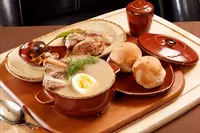The polish

The culture, history and traditions of the modern Republic of Poland are well known to us, as well as the national recipes of Polish cuisine.
Poland is located in Central Europe and borders on such states as the Russian Federation, Ukraine, the Republic of Belarus, the Czech Republic, Slovakia and Germany.
The earliest settlers in Polish territories were the ancient tribes of the Germanic Scythians and Goths. Much later, the tribes of the western glades, which are considered the ancestors of modern Poles, came to Polish lands.
The speech of the Passport Great State of the 16th century was formed on the basis of the primordially Polish lands, which annexed the equally well-known state of that time, the Grand Duchy of Lithuania. So the Slavs united into one state, so we can safely argue that many recipes for Polish cuisine arose on the basis of the merger of Slavic traditions and cultures of that time.
At the beginning of the XVII century, the rulers of Speech Paspolita aimed their eyes at Russia. The confrontation between Poles and Russians continued until 1772, when the first section of the Paspolita Speech took place, according to which part of the Polish territories were divided between Russia, Austria and Prussia.
Until the beginning of the 19th century, Poland as an independent state simply did not exist, its lands were part of various states of that time. Therefore, Polish culture, as well as the culinary tradition, incorporated the features of Russian, Austrian, Prussian, Belarusian, Ukrainian and other neighboring nationalities.
The turbulent 20th century was reflected in the Polish territories, which again became the subject of bargaining between the powerful. The Poles survived several uprisings, seizures, as well as two World Wars. As a result, Poland again turned out to be under the influence of Russian rulers, but only no longer emperors, but the secretaries general of the USSR.
And only with the collapse of the USSR did Poland receive complete independence and freedom of action, like the Republic of Poland. Such a rich and centuries-old history, as well as the neighborhood with a large number of original nationalities, could not but affect the Polish way of life.
Polish cuisine is a colorful puzzle, the components of which are recipes and Western European cuisine and Slavic cuisine. Currently, the traditions of Polish cooking are replenished with recipes for Asian cuisine.
Soups are considered one of the most popular dishes of Polish cuisine. Often, a Polish lunch or dinner consists of just one dish - soup. Since ancient times, Poles have been eating soup with bread from coarse flour. Among the most famous Polish soups can be distinguished - Red borscht (from beets), White borscht (from sauerkraut), Rosul (poultry broth with noodles), Grokhuvka (based on peas), Flak (from beef stomach) and Chernin (soup with goose blood).
On the second, Poles usually eat meat dishes with side dishes made of porridge (buckwheat) or cabbage. Cabbage is stewed or sauerkraut, pickles or pickled vegetables, mushrooms are often served as a side dish for meat. A famous dish of Polish cuisine and symbol of all Poland - Bigos or lazy cabbage rolls.
Polish Sorcerers, Polendwica and Saltison are also known. An interesting and zeppelin-like dish by Peza. Peze is prepared from potatoes and meat, but not cooked like zeppelins, but fried in a pan and given protomet in an oven.
For dessert, Poles bake pies and rolls with various fillings. The delicacy is considered to be a pie filled with wild rose. Among the national Polish drinks, you can distinguish vodka, various tinctures, as well as beer, which Poles like to drink warmed up with the addition of honey and seasonings, a special Polish type of mulled wine based on beer is obtained.
 Español
Español Français
Français Português
Português Русский
Русский 简体中文
简体中文 繁體中文
繁體中文 日本語
日本語 한국어
한국어 العربية
العربية Türkçe
Türkçe Қазақ
Қазақ Deutsch
Deutsch Italiano
Italiano Українська
Українська
